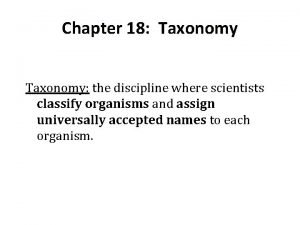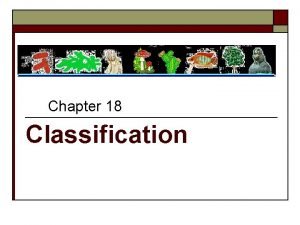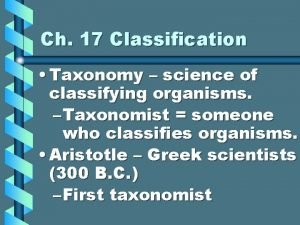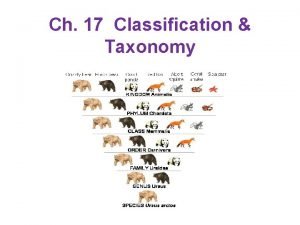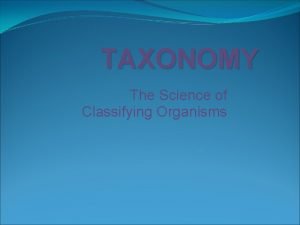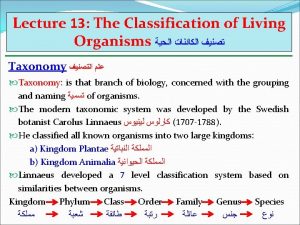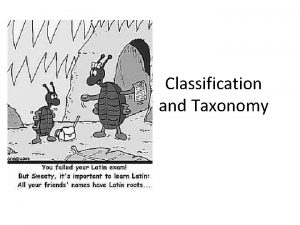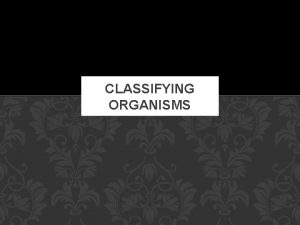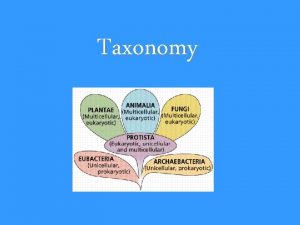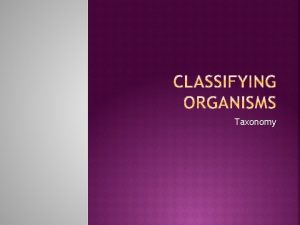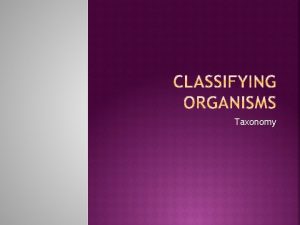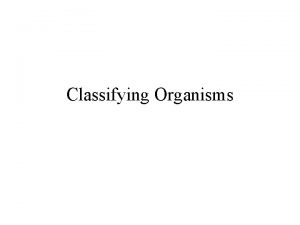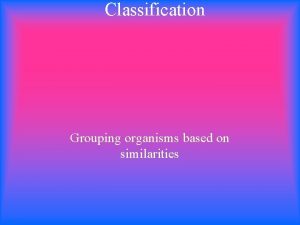CLASSIFICATION OF ORGANISMS The Necessity of Classifying TAXONOMY

























- Slides: 25

CLASSIFICATION OF ORGANISMS The Necessity of Classifying

TAXONOMY § also called “systematics” § the science of classifying organisms into groups

CLASSIFY to assign an organism to a particular classification group IDENTIFY to determine the group in which an organism belongs

THE HISTORY OF CLASSIFICATION

ARISTOTLE § based his groupings on observable characteristics artificial classification system § two major groups each with three subgroups § used for almost 2, 000 years

CAROLUS LINNAEUS § created a classification system in the mid-1700 s § based his system on observable characteristics § made a more developed system that is also more flexible

HIERARCHY OF THE CLASSIFICATION YSTEM Start with. Sthe broadest group or classification and work down to the most specific category.

kingdom phylum class order family genus species

domain kingdom phylum class order family genus species

The organisms in the kingdom Fungi were originally in the kingdom Plantae. Kingdom Animalia contains heterotrophic, eukaryotic, multicellular organisms.

CLASSIFICATION SYSTEM § Each group can be divided into several groups on the next level. § Each group has characteristics that all levels under the group possess. § Each level can be subdivided before reaching the next level.

Eubacteria Archaebacteria Protista Fungi Plantae Animalia

APPENDIX B

KINGDOMS EUBACTERIA & ARCHAEBACTERIA § prokaryotic § differ in the composition of their cell walls

KINGDOM PROTISTA § algae & protozoans • autotrophic and heterotrophic • mobile and stationary • unicellular and colonial § eukaryotic cells that aren’t animals, plants, or fungi

KINGDOM FUNGI § eukaryotic § all heterotrophic • unicellular and colonial

KINGDOM PLANTAE § eukaryotic § all multicellular with true tissues § most autotrophic

KINGDOM ANIMALIA § eukaryotic § all multicellular with true tissues § all heterotrophic

A mushroom is colonial because a. its cells lack true nuclei. b. it lacks true tissues. c. it is heterotrophic. d. it is stationary.

A cell with a Golgi body a. is prokaryotic. b. is eukaryotic. c. may be either prokaryotic or eukaryotic.

A brown protist is most likely autotrophic. a. true b. false

SCIENTIFIC NAMES

BINOMIAL NOMENCLATURE system of naming organisms in which each organism is given a genus and species name

USING SCIENTIFIC NAMES § example: Canis familiaris • “Canis” (capitalized) • “familiaris” (not capitalized) § both words italicized or underlined

WHY LATIN? § dead language § known by scholars § highly descriptive
 Kingdom family genus species
Kingdom family genus species Lesson 1 characteristics of life answer key
Lesson 1 characteristics of life answer key Classifying organisms worksheet
Classifying organisms worksheet Lesson outline classifying organisms
Lesson outline classifying organisms Lesson 2 classifying organisms answer key
Lesson 2 classifying organisms answer key The scientific discipline of classifying organisms
The scientific discipline of classifying organisms Discipline of classifying and naming organisms
Discipline of classifying and naming organisms Canis latrans classification
Canis latrans classification Why do scientists classify organisms?
Why do scientists classify organisms? Finding order in diversity
Finding order in diversity Discipline of classifying and naming organisms
Discipline of classifying and naming organisms Liger taxonomy
Liger taxonomy What is kendall and marzano taxonomy
What is kendall and marzano taxonomy Dear king phillip came over
Dear king phillip came over Binomial nomenclature consists of two names *
Binomial nomenclature consists of two names * Organisms taxonomy
Organisms taxonomy Organisms taxonomy
Organisms taxonomy Biology
Biology Sunflower classification
Sunflower classification Member of the same species
Member of the same species What are unicellular and multicellular organisms
What are unicellular and multicellular organisms Police necessity
Police necessity Can verb
Can verb Irrigation necessity
Irrigation necessity Necessity advisability and expectations
Necessity advisability and expectations Necessity of fuse
Necessity of fuse








